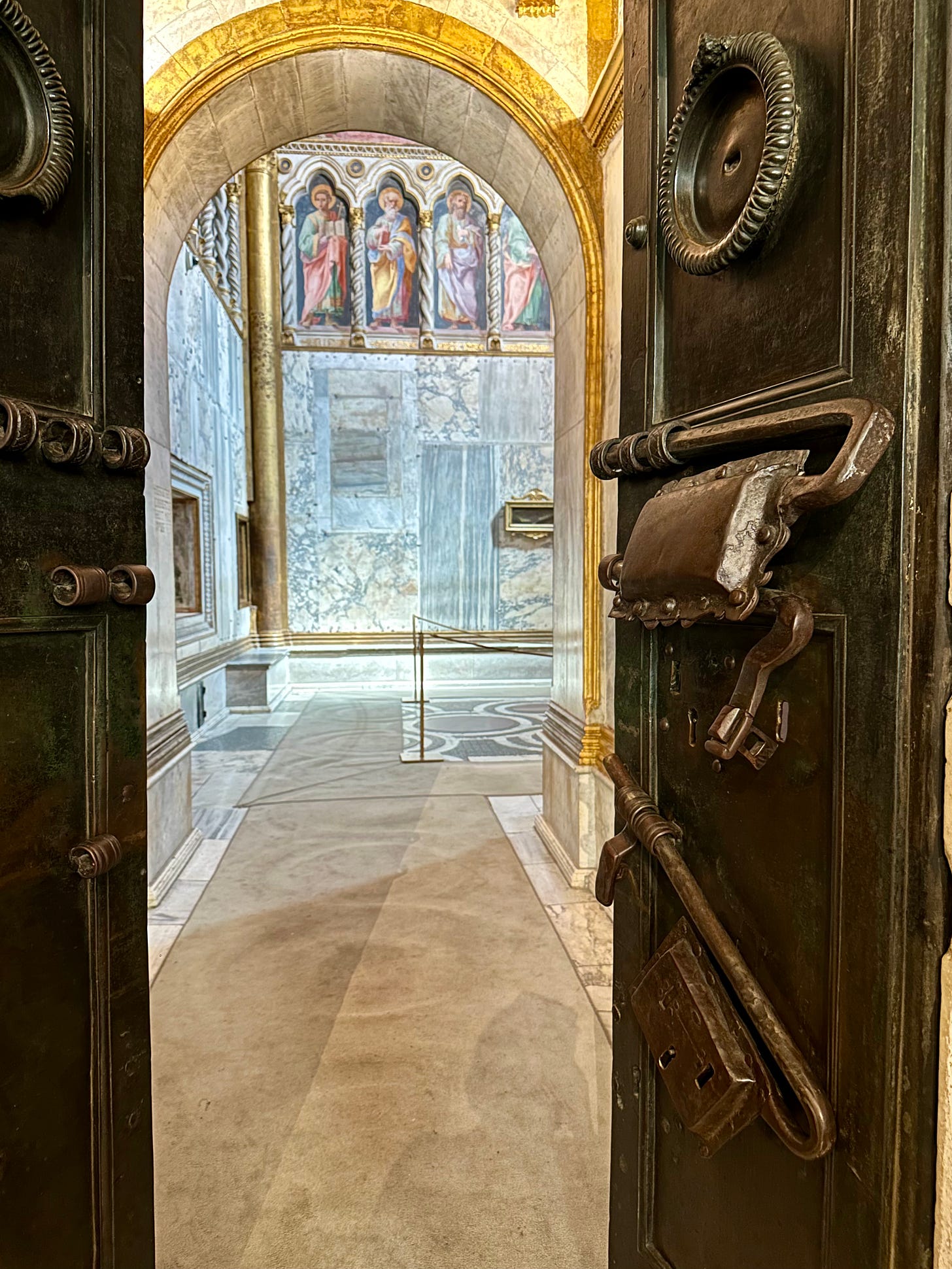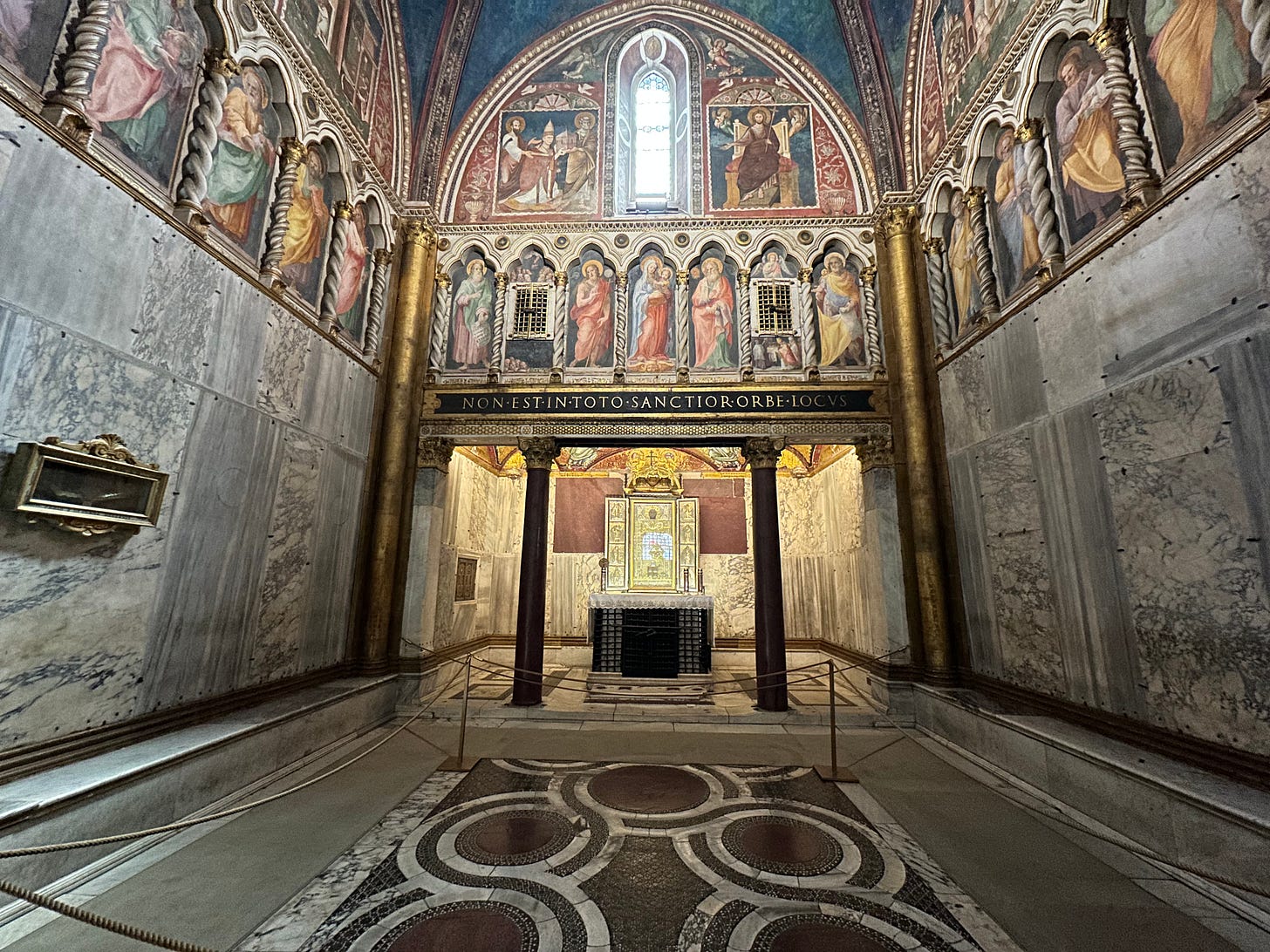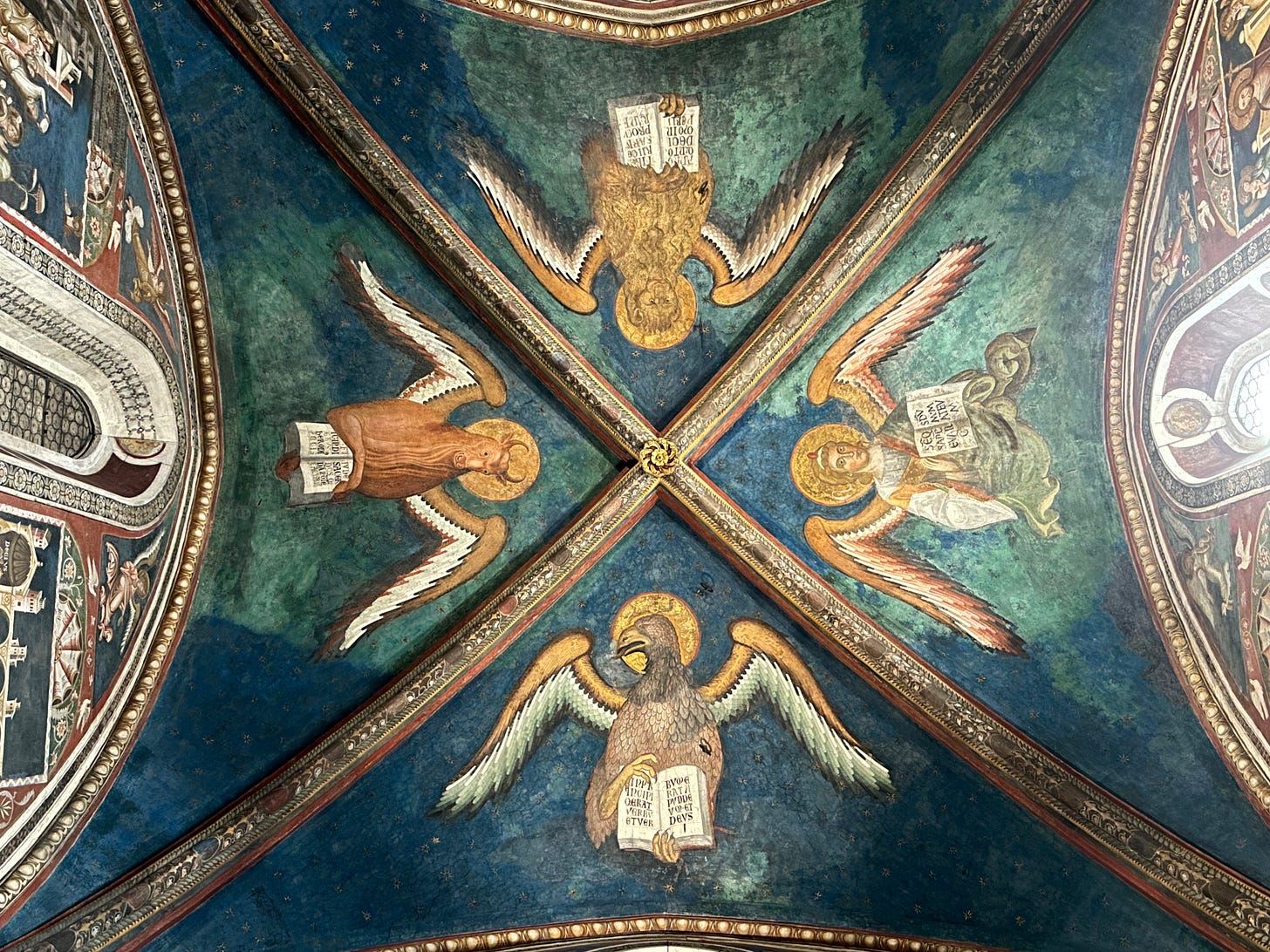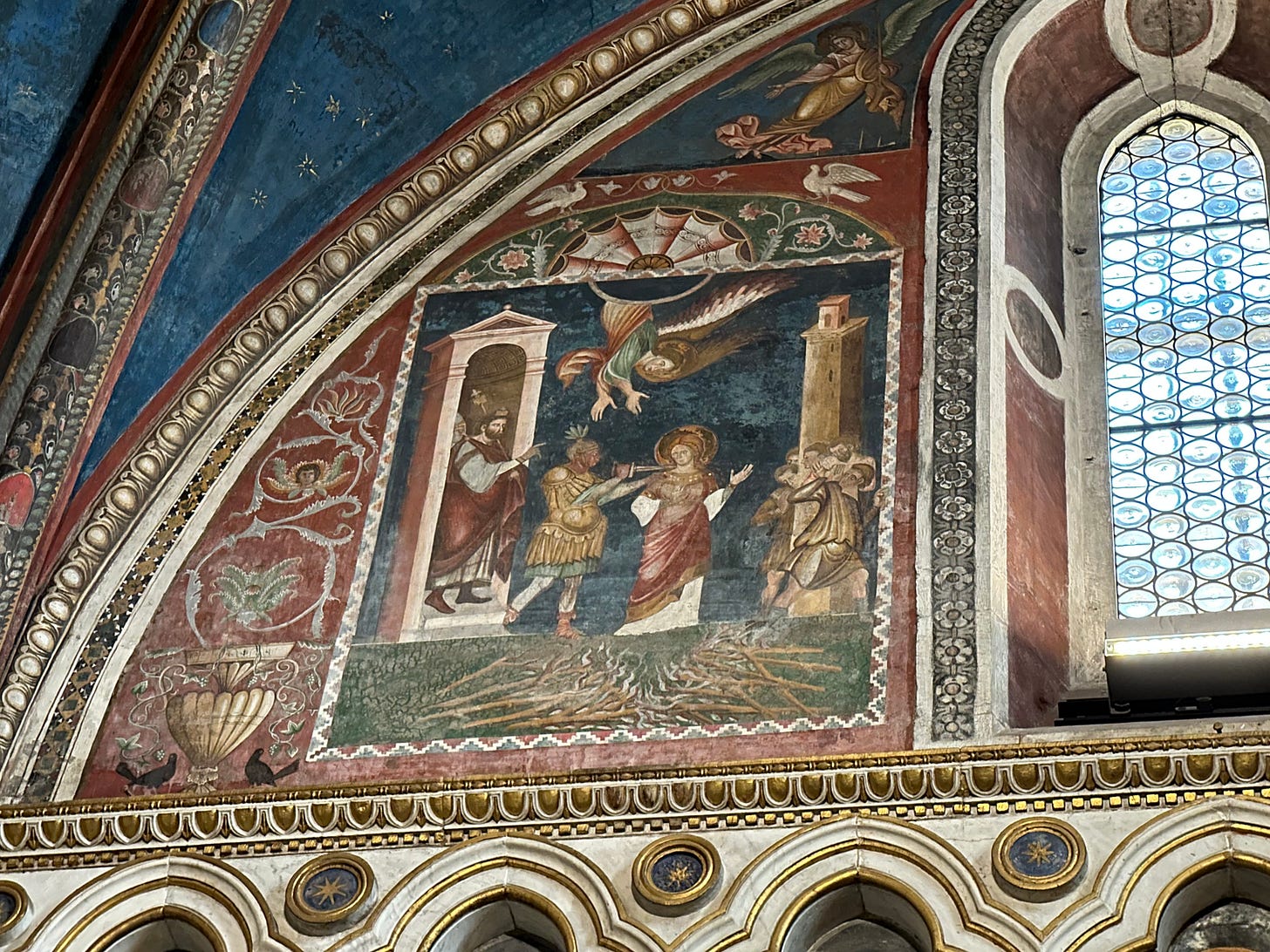San Lorenzo in Palatio ad Sancta Sanctorum
The Papal chapel of St Lawrence at the Lateran, the Holiest of Holies
Non est in toto sanctior orbe locus
There is no holier place in the world
Rome is unrelentingly astonishing, and it never ceases to amaze that places which would anywhere else be the single most famous thing to see are often deserted. For example, with the exception of groups of pilgrims around high days and holidays, you can usually have the complex of Rome’s cathedral, St John in Lateran, to yourself: the Mother Church of all of the Catholic World and the seat of the Bishop of Rome is, curiously, spectacularly under-visited.

The Lateran complex takes its name from the family which owned land there in the late Imperial period. By the late third century, as the crumbling of Rome’s fortunes gathered pace, and for the first time in almost six hundred years the city needed a wall. A glaring manifestation of inexorable decline if ever there was one. Just within these hurriedly erected Aurelian walls, south-east of the Colosseum, was the “new camp” of the equites singulares Augusti. The equites singulares were the personal cavalry guard of the emperor and the regiment dates to perhaps to the late first century. In October of 312, Constantine fought his co-ruler Maxentius at the Battle of the Milvian Bridge. Maxentius drowned in the Tiber, and the regiment of the equites singulares which had been loyal to him was disbanded. The Castra Nova was now redundant, and the site was swiftly earmarked for a quite different purpose.
Four months after his victory over Maxentius, Constantine sanctioned Christianity at Milan. It was no longer an illegal cult, and Christians were given a reprieve from persecution. However Christianity remained fundamentally incompatible with the polytheistic ancient Roman religion. Christians refused to worship the very gods which underpinned the city’s foundation, and without the veneration of Mars and Venus, the ancestors of Romulus, Rome’s divinely-ordained raison d’être was lost. The ancient and aristocratic families of the city were, unsurprisingly, wildly suspicious of the upstart religion from the eastern reaches of the Empire which subverted all they held dear. Constantine, on the other hand, was less concerned with the genius loci: he was a Roman but not from Rome and spent little time in the city, perhaps a total of eight months in his thirty year reign. He had been born in what is now Serbia, educated at Nicomedia, and proclaimed tetrarch upon his father’s death at Eboracum, modern York, near the northernmost reaches of Empire. The gradual decentralisation of Rome’s territories was by now complete.

Constantine was, however, aware of the importance of placating aristocratic sensibilities. If a state-sanctioned place of Christian worship was to be built in the city it clearly could not be built in the heart of Rome’s most archaic past. Instead the land of the Castra Nova provided a splendid solution on the edges of the urbs. And so it was that the first church recognised by imperial government was built not over the tomb of a martyr as the Constantinian basilicas which followed would be—St Peter’s in the Vatican; St Paul, St Agnes and St Lawrence outside the Walls—but on the site of the barracks of a disbanded regiment.
Within seven decades Christianity went from underground cult to established religion of state. The priestly title pontifex maximus, held by emperors since the time of Augustus (for whom it was also an ancient office), passed to the leader of the Roman Church. Today, over twenty-one centuries after the death of Augustus, the Pontifex Maximus is an elderly gentleman from Argentina who’s on Instagram. Isn’t that fabulously, dizzyingly wild?
Following the fall of Empire, popes would supplant emperors, and around the Cathedral of Rome the palace of the popes grew. The Lateran Palace was an organic, higgledy piggledy complex sprawling across the far reach of the Caelian Hill. After the Babylonian captivity and the definitive return of the papacy from Avignon, the medieval palace was abandoned in favour of a more defensible site at the Vatican by St Peter’s.
Two centuries later Pope Sixtus V, pioneer of the sledgehammer school of town-planning, razed through the crumbling Lateran. Even his notable enthusiasm for late Renaissance rationalisation drew the line at demolishing the Sancta Sanctorum, the papal chapel of the Lateran first mentioned in the Liber Pontificalis in the eighth century.
Dedicated to the Roman martyr St Lawrence, its name means “The Holiest of Holies” both for the panoply of relics it traditionally housed, and also an allusion to the most sacred area of the Tabernacle built by Moses which was home to the Ark of the Covenant. Under the altar of the Sancta Sanctorum in a strongbox is a ninth century box of cypress wood said to contain the relics of thirteen saints. It is considered by Catholics to be analogous to the Ark of the Covenant and was first placed there by Pope Leo III, the man who crowned Charlemagne in the Vatican basilica on the night of Christmas of the year 800.
On the altar above is the Lateran Acheiropoieta ( literally “not painted by human hand”; tradition says the image was begun by St Luke the Evangelist and completed by angels). The sacred image shows Christ in Majesty, though it is protected by an embossed silver revetment, and dates perhaps to the fifth or sixth centuries, though it has undergone umpteen overpaintings and restorations in the intervening one and a half millennia. Above that is the motto, seen in the second photograph, there is no holier place in the world.
The chapel underwent major remodelling during the reign of Nicholas III and the frescoes and mosaics date to circa 1278. They feature the proto-martyr Stephen; the patrons of Rome, Peter and Paul; the Roman martyrs, Lawrence and Agnes; and Nicholas, the name saint of the incumbent pope. A laconic inscription near the entrance tells us that a certain Magister Cosmatus was responsible for the stone cladding of the walls and the decorative floor. His is one of the names which gave rise to the term Cosmatesque coined in the late nineteenth century by Camillo Boito.
Sixtus V’s dramatic demolition of much of the Lateran complex rather beached the Sancta Sanctorum, leaving it high and dry. Domenico Fontana was employed to move the Holy Staircase to lead up to the chapel, and to encase both chapel and stairs in a new purpose-built structure.
And so it the holiest of holies sits behind an example of late sixteenth century restraint on the corner of piazza di San Giovanni in Laterano. Opposite is a now defunct cafe where on my first evening after moving to Rome aged twenty-two—a damp, cold, Saturday night in January of 2000—I ate a piece of pizza and drank a Coke under unforgiving neon while the barista swept up around me.

As I reread Bill Bryson to stave off incipient pangs of homesickness, I was entirely unaware that outside the window was a medieval treasure trove of relics, frescoes, mosaics, and repurposed stone originally quarried in the distant reaches of Empire. The thing that’s pretty astonishing is that, twenty-three years later, when I visited three weeks ago to take these photographs during possibly the busiest summer Rome has ever seen I had it all to myself. And if you avoid weekends and observed feast days, for €3.50 so can you.
All photos taken on 2 August 2023 at about 11am
Sancta Sanctorum and the Holy Staircase
Piazza San Giovanni in Laterano
Mon-Sat 9am-1.30pm; 3pm-5.30pm
Sun and observed holidays in the Catholic calendar 3pm-5.30pm















Wish I’d known you when we travelled there. People were climbing the stairs and we did not like to disturb them and So.….. we missed this beautiful chapel. Now after reading this I regret that we were polite.
Judy
A jewel lands again in my Inbox ...